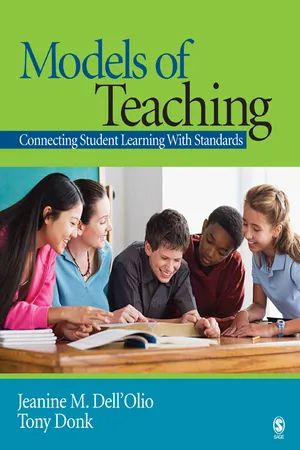![]()
part 1
What We Teach and Why
Part 1 will provide the framework for understanding the 10 models of teaching presented in this book. Concepts introduced in Part 1 will be discussed in Part 2 in the context of each model of teaching. Chapter 1 explains the standards-based reform movement and describes its effect on education in America. It also defines content standards and benchmarks, describes how they are developed, and illustrates the types of knowledge they include. In Chapter 2, you will be introduced to five distinct philosophies of curriculum and instruction. Each of these five philosophies answers the question What is the purpose of schools? in a different way. You may find your own beliefs about teaching and learning reflected in one or more of these five philosophies. Your personal philosophy of curriculum and instruction will become apparent in how you choose to address content standards and benchmarks in your own classroom. Chapter 3 will provide an overview of current assessment practices—ways that teachers can see whether their students have understood the material required in the standards and benchmarks set for their grade levels.
Concepts introduced in Part 1 are essential to your understanding of the models of teaching presented in Part 2 and the process described in Part 3 for developing curriculum using content standards and benchmarks.
![]()
chapter 1
Working With Standards and Benchmarks
Perhaps the biggest question facing novice and veteran teachers alike is, What will I teach? After securing a new teaching position or shifting to a new grade level, all teachers must consider what content their students need to know, which skills they must develop, and at what level of proficiency they must be able to demonstrate those skills. For the high school biology teacher, the answer may seem obvious. However, on further examination, it becomes clear that the discipline of biology is deep and broad. The tenth-grade biology teacher must consider what students already know and at what level they can demonstrate their understandings and skills. Likewise, a kindergarten teacher needs to know what students bring to each teaching and learning situation across a broad spectrum of subjects and skills, as well as the levels and competencies that need to be targeted. These concerns have always loomed large in the daily work of teachers, and they continue to do so today as teachers, administrators, and others in the field of education look for guidance in implementing standards-based education.
To illustrate the issues and questions raised above, I (T. D.) will share an experience in my own early history as an educator. I was teaching fourth grade in my first elementary school setting. I did what many of my colleagues did: I used the textbooks adopted by the district to guide my instruction. I also reviewed the district report card so that I would know what categories and levels of performance needed to be reported to parents and students. After several days of poring over these documents, I was relatively satisfied that I understood the goals and aims for fourth-grade students in my school district. I then set my sights on what seemed to be the next logical step: deciding how to create learning experiences that would match my understanding of this curriculum. All seemed to be going relatively well until the day my fourth-grade teaching partner poked her head through the classroom door and asked me how our “bird projects” were coming since a local 4-H judge was scheduled to come in and rate them in a couple of weeks! After determining that her comments weren’t the product of a cruel sense of humor, I began asking several questions: “What project?” “What judge?” “Is this required?” “Is it in the textbook for science?” After some time (and moments of panic) I discovered that students were to study local bird populations and build birdhouses as an annual project to be evaluated by a local 4-H official. The project was not listed in the textbook or even on the report card, but it was a requirement for all fourth-grade students. It seems that no one had remembered to tell me about it. My class did ultimately study the local bird population, and we managed to put together several birdhouses in assembly-line fashion, but I spent much of the rest of the year wondering what other content I was expected to cover that hadn’t been fully explained to me.
As my story illustrates, new teachers and those new to a subject or grade level need guidance in determining what students need to know and be able to do, as well as expectations for proficiency levels. While teachers must also have models for how to develop appropriate teaching and learning opportunities, knowing what to teach and when are the essential first steps in the process. Teachers just entering the field, as well as those moving within a system, stand to benefit from the last several years of work in standards-based reform in education. In short, this major reform effort has sought to articulate what students need to know and be able to do in several disciplines and at all grade levels. In this chapter, we begin with a historical look at the roots of this movement and its current status and implications for classroom teachers. We will also discuss the types of standards and the terminology that have evolved from the movement and the ways they can serve as guideposts for classroom teachers considering both what to teach and how to promote levels of proficiency among their students. Along the way, we will also explore some of the issues raised about the development and use of various types of standards to guide instruction and assessment. Our goal in this chapter is not to teach you how to develop standards. Rather, our intention is to help you better understand where they come from and how you can and may be expected to use them in your work with students. Once you understand how to use standards and benchmarks to determine what to teach, the remainder of this book will help you determine models that best meet those teaching and learning goals.
The Standards-Based Reform Movement
While the call for higher standards and measures for accountability has a long history in American schooling, the current standards-based reform movement is a relatively young tradition. The release of the report A Nation at Risk in 1983 is often cited as the beginning of the movement (Kendall & Marzano, 2000, p. 1). This report denounced the state of education in the United States and called for major reforms. A variety of sources—governmental agencies, business groups, professional organizations focused on education, and schools—responded. In short, although sometimes wary of the substance and form of change, nearly all players seemed to agree that reforms designed to raise standards and accountability in the K–12 system of schools were necessary.
In their short outline of the history of the standards-based reform movement, Kendall and Marzano (2000) note several important events that led to the current standards and accountability system that governs schooling in the United States. Shortly after the report was issued, the National Council of Teachers of Mathematics (NCTM) began writing Curriculum and Evaluation Standards for School Mathematics (Kendall & Marzano, 2000, p. 2). This document represented an early attempt by a subject-centered professional organization to outline how the discipline of mathematics should be divided, as well as standards for those who teach mathematics at all levels of the K–12 system. The NCTM was among the first organizations to provide such a framework, and many other national professional organizations have followed suit in the past several years.
Another set of milestones noted by Kendall and Marzano (2000) included the meeting of President George H. W. Bush and the governors of all 50 states in Charlottesville, Virginia, in 1989. The result of that meeting was a call for new standards in five subjects covered in all schools: mathematics, history, geography, science, and English. In addition, the first President Bush used his 1990 State of the Union address to outline “National Goals for the Year 2000.” This set of goals was further promoted when Congress established the National Education Goals Panel. At nearly the same time, the secretary of labor established the Secretary’s Commission on Achieving Necessary Skills to consider the kinds of skills students would need to develop to ultimately and successfully enter the workforce. These efforts were advanced again when President Clinton signed the Goals 2000: Educate America First Act. This law called for standards at the national and state levels, as well as state assessment tools. It also added economics, civics, government, the arts, and foreign language to the list of subjects to be covered by standards (Kendall & Marzano, pp. 2–3).
The standards-based reform movement has promoted high Levels of accountability that include state-mandated assessments for K–12 students.
In addition to the work being done at the national level, some states began to develop curriculum frameworks that outlined standards for school subjects taught within a state. Most notably, the state of California began in 1983 to develop a framework and set of content standards to be used in its public schools. President Clinton used his State of the Union address in 1997 to urge all states to not only develop high standards for all students but also establish a set of assessments for measuring reading proficiency in the fourth grade and mathematics proficiency in the eighth grade (Kendall & Marzano, 2000, pp. 2–5). By 1990, most states had adopted assessments to measure student achievement in a variety of subjects (Montgomery, Ranney, & Growe, 2003).
The convergence of efforts by national professional organizations, state educational agencies, business, and national governmental bodies is most recently reflected in the reauthorization of the Elementary and Secondary Education Act, commonly referred to as the No Child Left Behind Act of 2001. This act calls on each state to set standards for what all students “should know and learn” and to measure their achievement on an annual basis (No Child Left Behind Act of 2001 [Glossary]). The No Child Left Behind Act places heavy emphasis on assessment of student achievement. Under assessment, the glossary for the No Child Left Behind Act states that
Under No Child Left Behind, tests are aligned with academic standards. Beginning in the 2002–03 school year, schools must administer tests in each of three grade spans: grades 3–5, grades 6–9, and grades 10–12 in all schools. Beginning in the 2005–06 school year, tests must be administered every year in grades 3 through 8 in math and reading. Beginning in the 2007–08 school year, science achievement must also be tested.
The act also calls for publication of the results on an annual basis and adequate yearly progress (AYP), which is defined as “An individual state’s measure of yearly progress toward achieving state academic standards. ‘Adequate Yearly Progress’ is the minimum level of improvement that states, school districts and schools must achieve each year” (No Child Left Behind Act of 2001). Schools that do not make AYP can be sanctioned in a variety of ways.
In a relatively short span of time, standards-based reform has essentially become law (Resnick, Rothman, Slattery, & Vranek, 2004), and it has drawn both supporters and critics. While some oppose the mandates of No Child Left Behind, others embrace this act as a much needed reform of U.S. schools to both establish standards and ensure accountability at all levels. Our goal here is not to take a political stand on the legislation itself but rather to briefly examine some of the potential merits and limitations of the standards-based reform movement in general.
Proponents of the standards-based movement often argue that the development of standards makes the material to be learned and the level of proficiency to be attained transparent for all. Teachers are told what to teach but are free to select models of teaching that best allow them to meet the standards. In addition, clearly articulated standards allow parents and students to see the goals of schooling and measure progress toward those goals in various content areas. Proponents further argue that the increased accountability of testing based on the standards provides a feedback loop for teachers so that improvements can be made to curriculum and instruction. Others contend that clearly articulated standards will provide an opportunity to close the gap in educational achievement for traditionally marginalized students: poor and minority students (Cavazos, 2002; Riley, 2002; Paige, 2002; Cohen, 1996; Darling-Hammond, 1997; Ogawa, et al., 2003; all cited in Kirschner, 2004).
Critics of the standards-based movement have often worried about the tension between federal, state, and local control of schools. Some worry that state or national standards will, for all intents and purposes, eliminate the local control over school curriculums that has historically been the rule in this country. Others have worried that the high-stakes and mandated tests might not be well aligned with standards and curriculum, putting students at a disadvantage. Still others have concerns that weighty emphasis on a system of accountability that relies heavily on suc...



